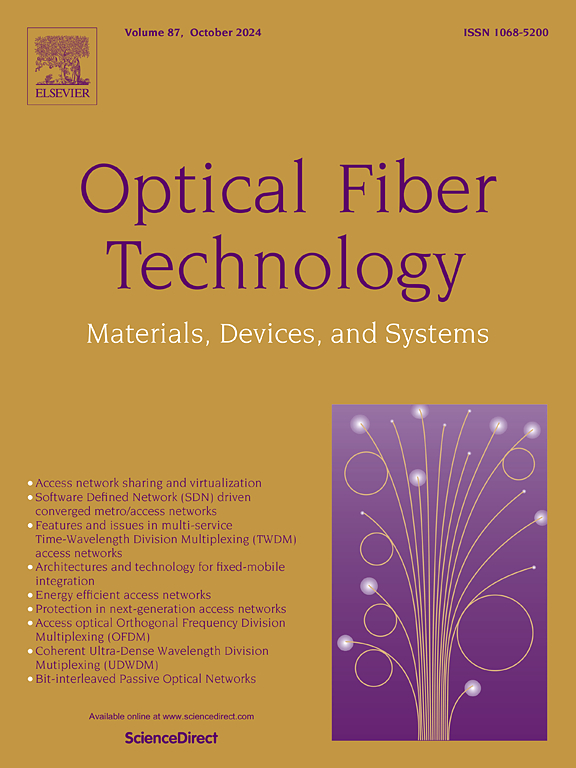基于中继辅助 UWOC-SMF-FSO 混合链路的水下无线光传感器网络
IF 2.6
3区 计算机科学
Q2 ENGINEERING, ELECTRICAL & ELECTRONIC
引用次数: 0
摘要
水下物联网(IoUTs)将水下设备连接起来,以进行通信、感知周围环境并传输数据。声学通信面临带宽限制,因此无空间光学(UWOC-FSO)的水下无线光通信混合系统成为一种很有前景的替代方案。然而,保持足够的功率预算和信噪比(SNR)是一项具有挑战性的任务,因此在水-光纤-空气接口处从可见光到红外的波长转换(WT)对于可靠的信号传输至关重要。本文提出了一种水下无线光通信-单模无光纤空间光学(UWOC-SMF-FSO)混合链路,它基于光检测、重调制和转发(PRF)中继以及强度调制-直接检测(IM/DD)方案,适用于 8 × 1-Gb/s 的水下光无线传感器网络(UWOSN)。PRF 中继器安装在遥控水下机器人(ROV)上,用于执行从可见光范围到红外范围的 WT。采用伽马-伽马信道模型,利用误码率(BER)和质量因子(Q因子)指标,分别分析了水下和自由空间光学信道在不同水体和天气条件下的传感器性能。模拟结果表明,在不同的水体和天气条件下,传感器的前向纠错(FEC)目标误码率达到了 10-4。这项研究的结果表明,所提出的 UWOC-SMF-FSO 混合链路具有灵活性,能够抵御不利的信道影响,是未来高速长距离物联网技术的潜在候选方案。本文章由计算机程序翻译,如有差异,请以英文原文为准。
Relay aided UWOC-SMF-FSO based hybrid link for underwater wireless optical sensor network
The Internet of Underwater Things (IoUTs) connects underwater devices to communicate, sense surroundings, and transmit data. Acoustic communication faces bandwidth limitations, making underwater wireless optical communication-free space optics (UWOC-FSO) hybrid systems a promising alternative. However, maintaining sufficient power budget and signal-to-noise ratio (SNR) is a challenging task, making wavelength translation (WT) from visible to infrared (IR) at the water-fiber-air interface crucial for reliable signal transmission. In this paper, we propose an underwater wireless optical communication-single mode fiber-free space optics (UWOC-SMF-FSO) hybrid link based on a photo-detection, remodulate, and forwarding (PRF) relay and intensity modulation-direct detection (IM/DD) scheme for 8 × 1-Gb/s underwater optical wireless sensor network (UWOSN). The PRF relay is installed at a remotely operated underwater vehicle (ROV) to perform WT from visible range to IR. The performance of the sensors is analyzed for different water bodies and weather conditions of underwater and free space optics channels, respectively using metrics of Bit-error rate (BER) and Quality factor (Q-factor) employing Gamma–Gamma channel model. The simulation results show that forward-error correction (FEC) target BER of 10−4 for sensors is achieved under different water bodies and weather conditions. The results obtained from this study show that the proposed UWOC-SMF-FSO hybrid link is flexible, resilient to adverse channel effects, and can be a potential candidate for implementation of high-speed long-distance future IoUTs.
求助全文
通过发布文献求助,成功后即可免费获取论文全文。
去求助
来源期刊

Optical Fiber Technology
工程技术-电信学
CiteScore
4.80
自引率
11.10%
发文量
327
审稿时长
63 days
期刊介绍:
Innovations in optical fiber technology are revolutionizing world communications. Newly developed fiber amplifiers allow for direct transmission of high-speed signals over transcontinental distances without the need for electronic regeneration. Optical fibers find new applications in data processing. The impact of fiber materials, devices, and systems on communications in the coming decades will create an abundance of primary literature and the need for up-to-date reviews.
Optical Fiber Technology: Materials, Devices, and Systems is a new cutting-edge journal designed to fill a need in this rapidly evolving field for speedy publication of regular length papers. Both theoretical and experimental papers on fiber materials, devices, and system performance evaluation and measurements are eligible, with emphasis on practical applications.
 求助内容:
求助内容: 应助结果提醒方式:
应助结果提醒方式:


